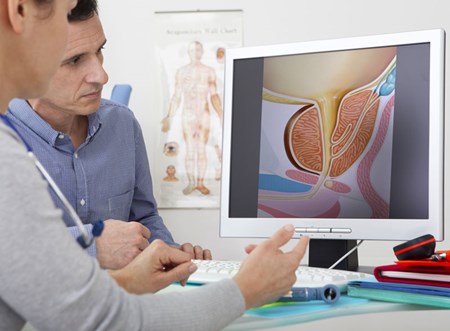
What Comes Next After Prostate Cancer Diagnosis?
Prostate cancer is the most commonly diagnosed cancer among men.
Chances are, if you are diagnosed with prostate cancer, one of your friends or members of your close-knit community also was diagnosed with prostate cancer.
In fact, prostate cancer is a very slow-growing cancer in most cases and as a result, many people die with prostate cancer and not from prostate cancer.
Living with Prostate Cancer – What Treatment Options are Available
Because prostate cancer is so common, there are several different treatment options available, including surgery, radiation and active surveillance.
With surgery, incontinence and erectile dysfunction are common, but oftentimes temporary side effects.
All men who have surgery will have urinary incontinence, or leakage of urine.
Following surgery, most men (95-97 percent) will regain control of their urination by one year after their procedure.
Very few men have permanent and life-altering incontinence or leakage.
Patients who are at risk for permanent leakage are often older (age 70-plus), are diabetic, smoke or are obese (BMI great than 30).
Erectile dysfunction is also a common side effect after surgery. Most times, it can take up to 18 months for men to regain their erections after surgery.
The most important factors that predict regaining erectile function are the status of a patient’s erectile function prior to surgery, and whether a nerve-sparing procedure was performed.
Patients who start off with great erections are much more likely to have good erections after surgery.

Radiation side effects typically occur 5-10 years after initial treatment and can include severe urinary symptoms, such as urgency, frequency, urinary retention, excessive nighttime urination (nocturia) and leakage.
Other side effects may include:
- Urethral stricture disease – A medical condition in which the urethra narrows and restricts urinary flow.
- Urinary tract fistulas – An abnormal opening within a urinary tract organ, or an abnormal connection between a urinary tract organ and another organ.
- Secondary cancers.
When deciding to pursue treatment, the patient and his overall health is the most important factor.
It is also important to understand that each treatment option comes with different side effects and risks that can affect a patient’s quality of life long after the cancer has been cured.
Patients with a life expectancy of less than 10 years and with a less-aggressive form of prostate cancer can very safely watch their cancer instead of pursuing treatment that could leave them with life-altering side effects from treatment.
Improvements in Patient Care
Currently, there are many new advancements in prostate cancer treatment focused on two areas of prostate cancer care – prostate cancer diagnosis, and the treatment of patients with metastatic disease.
New biomarkers and methods to reduce the number of patients who need repeat biopsies, as well as the number of patients who need biopsies in the first place, are helping to prevent unnecessary procedures and the over-diagnosis of disease.
Also, in the world of prostate cancer treatment, there are many new medications that have been developed for patients with metastatic disease, or cancer that has spread outside of the prostate.
These medications have developed new ways to suppress the male hormone testosterone, which feeds prostate cancer.
By developing new ways to suppress this hormone, we can extend the life of patients who have metastatic disease.

The Importance of Support
Even though prostate cancer is very common, receiving a diagnosis is no less difficult.
First and foremost: YOU ARE NOT ALONE!
Seek out family, friends and members of the community for support. Chances are one or more have already gone through the process of diagnosis and treatment of prostate cancer.
Hearing how someone close to you got through the initial diagnosis and treatment is extremely important.
No matter how much your doctor can prepare you for the diagnosis, the treatment and recovery, it will never replace the firsthand experience someone who has gone through the process can provide.
Secondly, educate yourself, but do so with help from your doctor and reputable sources.
Prostate cancer, more so than many other cancers, is very confusing. There are so many different options and treatments, with many nuances that can be very overwhelming.
While this may seem like a bad thing, it really just means prostate cancer is so curable that many different treatments work just as well.
However, this means that when deciding on the right treatment for YOU, take the time to truly understand the long-term side effects that your treatment will have.
At Pali Momi Medical Center, our team of board-certified urologists offer a multidisciplinary, innovative approach in providing the best possible care for our patients. We are committed to collaborating with experts across all specialties in tailoring the most beneficial treatment for you.
For more information, contact us at 808-488-3400 or visit PaliMomi.org/Urology.
Published on: September 17, 2018





